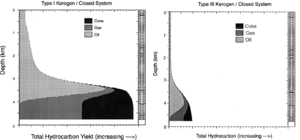Kerogen type and hydrocarbon generation
Kerogen consists of many fractions, each converting to hydrocarbons at a specified rate. This rate of conversion to hydrocarbons is defined by a first-order rate equation known as the Arrhenius law:
where:
- A = Arrhenius factor
- E = activation energy
These are generally referred to as kinetic parameters. They can be measured using various pyrolysis techniques and are different for each distinct kerogen analyzed.

Hydrocarbon generation—depth and yield
The depth of hydrocarbon generation and the yield of individual hydrocarbon phases are primarily a function of the kinetics of the kerogen-hydrocarbon conversion. Burial history and catalytic effects, due to source rock matrix chemistry, affect the rate of generation, although these effects are secondary to the kinetic effects.
The following hydrocarbon generation vs. depth plots (Figure 1 for types I (left) and III (right) kerogens) are based on identical burial and thermal conditions. Thus, they depict the difference in the depth of hydrocarbon generation, based on kerogen type alone. Type I kerogen generally has a shallower liquid hydrocarbon zone and generates significantly larger amounts of hydrocarbons. The onset of generation is indicated by the change in the slope of the curves.
Timing hydrocarbon generation
Variations in the kinetic parameters affect predictions of the present-day distribution of hydrocarbon generation zones and also influence when, in geologic time, a potential source interval generates. Figure 2 compares the timing of hydrocarbon generation from type I kerogen (left) to type III (right). The onset of hydrocarbon generation is indicated by the dramatic change in slope of the curves: 110-100 Ma for type I and 90-80 Ma for type III. The difference in timing shown in this example is based only on the different kinetic parameters of the kerogen types.
Recommendations
Conduct kerogen kinetic analysis on samples from the basin being modeled. If samples are not available, standard values for types I–III are available from[1][2][3]. Apply these values after carefully classifying the kerogen type in terms of the depositional environment of the individual source intervals.
See also
References
- ↑ Burnham, A., K., 1989, A Simple Model of Petroleum Formation and Cracking: Lawrence Livermore Laboratory report UCID 21665, March 1989. Basic review of the kinetic conversion of kerogens to hydrocarbons.
- ↑ Burnham, A., K., Sweeney, J., J., 1990, Modeling Maturation and Migration of Petroleum: Lawrence Livermore Laboratory report UCRL 102602, rev. 1.
- ↑ Tissot, B., P., Espitalie, J., 1975, L'evolution thermique de la matiere organique des sediments: aplications d'une simulation mathematique: Rev. IFP, vol. 30, p. 743–777. In French. Contains basic IFP kerogen kinetic data, DOI: 10.2516/ogst:1975026
